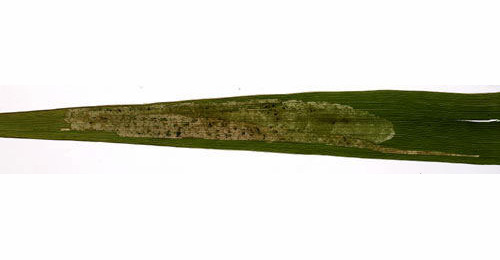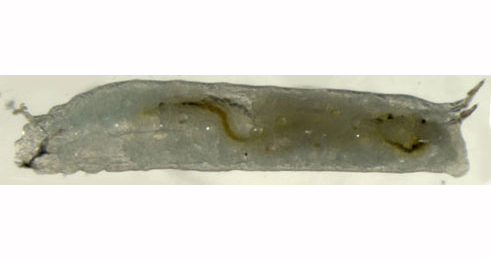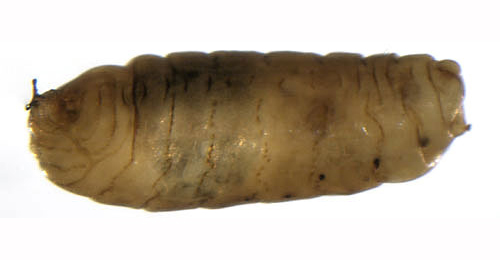|
||||||
|
MILIUM. Millets. [Poaceae] |
|
Two species of Milium are recorded in Britain. These include Early Millet (M. vernale) and Wood Millet (M. effusum). Both are native species. Nineteen British miners are recorded on Milium. Nearly 100 British miners or possible miners are recorded on grasses in Britain. A key to the European miners recorded on Milium is provided in Bladmineerders van Europa. It is recommended that adults of all miners on grasses be reared to be certain of their identity. |
Key for the identification of the known mines of British |
|
Note: Diptera larvae may live in a corridor mine, a corridor-blotch mine, or a blotch mine, but never in a case, a rolled or folded leaf, a tentiform mine or sandwiched between two more or less circular leaf sections in later instars. Pupation never in a cocoon. All mining Diptera larvae are leg-less maggots without a head capsule (see examples). They never have thoracic or abdominal legs. They do not have chewing mouthparts, although they do have a characteristic cephalo-pharyngeal skeleton (see examples), usually visible internally through the body wall. The larvae lie on their sides within the mine and use their pick-like mouthparts to feed on plant tissue. In some corridor miners frass may lie in two rows on alternate sides of the mine. In order to vacate the mine the fully grown larva cuts an exit slit, which is usually semi-circular (see Liriomyza huidobrensis video). The pupa is formed within the hardened last larval skin or puparium and as a result sheaths enclosing head appendages, wings and legs are not visible externally (see examples). See Key to non-Diptera. |
|
| 1a > Leaf-miner: Larvae
feed singly, forming an upper surface linear-blotch mine. Pupation
either internal or external, with the puparium loosely glued to
the leaf (Spencer, 1976:
91).
Oviposition near the leaf margin, at some distance from the leaf tip. From there develops an upper-surface corridor-blotch. At first the mine ascends as a narrow corridor towards the leaf tip, then the direction turns and the mine, steadily widening, descends in the direction of the leaf base. Frass irregular, in rather coarse grains. Larva solitary. Pupation mostly outside the mine; in that case the puparium often sticks to the leaf. |
|
 Mine of Agromyza albipennis on Phalaris arundinacea Image: © Willem Ellis (Bladmineerders van Europa) |
|
|
|
| Agromyza albipennis Meigen, 1830 [Diptera: Agromyzidae]. | |
1b > Leaf-miner: Deep mine, broadened irregularly. Pupation external. Puparium reddish brown to black |
|
|
|
| Agromyza cinerascens Macquart, 1835 [Diptera: Agromyzidae]. | |
| 1c > Leaf-miner: Long upper-surface corridor usually containing several larvae that graze shoulder to shoulder from the leaf tip downwards. Pupation outside the mine. Mines and larvae are indistinguishable from those of A. nigrella. | |
|
|
| Agromyza mobilis Meigen, 1830 [Diptera: Agromyzidae]. | |
| 1d > Leaf-miner: Larval leaf mine starts as a narrow channel running towards apex of leaf but later develops into a broad blotch running downwards. Frass largely diffused, giving the mine a characteristic greenish appearance. Pupation external, puparium reddish brown | |
|
|
| Agromyza nigrella (Rondani, 1875) [Diptera: Agromyzidae]. | |
| 1e > Leaf-miner: Broad lower surface mine which generally starts at the leaf apex.The mine is somewhat irregular in depth. Frass in irregular black-green, frequently melted grains, mostly along the edges of the mine. Larva solitary. Pupation generally internal. | |
|
|
| Cerodontha muscina (Meigen, 1830) [Diptera: Agromyzidae]. | |
| 1f > Leaf-miner: Usually a number of larvae together in a mine. Broad elongated mine; the form is dependent of the leaf form of the host plant. Frass green. Pupation in the mine | |
|
|
| Cerodontha incisa (Meigen, 1830) [Diptera: Agromyzidae]. | |
| 1g > Leaf-miner: Narrow whitish mine, with frass in distinct black lumps. Pupation
internal (Spencer, 1976:
422).
Whitish, upper-surface, descending corridor, about halfway up the blade. Frass in distinct black grains that are lying further apart than their diameter. Pupation in the mine. |
|
|
|
| Chromatomyia fuscula (Zetterstedt, 1838) [Diptera: Agromyzidae]. | |
1h > Leaf-miner: A substantial linear mine. Pupation internal; posterior spiracles projecting through the epidermis (Spencer, 1976: 449). Elongated, shallow, upper-surface or lower-surface blotch, not infrequently several in one leaf. Frass in strings or pearl chains. Pupation within the mine. |
|
 Mine of Chromatomyia milii on Holcus lanatus Image: © Willem Ellis (Bladmineerders van Europa) |
|
 Chromatomyia milii larva, lateral Image: © Willem Ellis (Bladmineerders van Europa) |
|
 Chromatomyia milii larva, dorsal Image: © Willem Ellis (Bladmineerders van Europa) |
|
|
|
| Chromatomyia milii (Kaltenbach, 1864) [Diptera: Agromyzidae]. | |
| 1i > Leaf-miner: Long, narrow, whitish mine. Pupation internal (Spencer,
1976: 453); anterior spiracles projecting through the epidermis.
Whitish, upper-surface, rather narrow corridor with comparatively large frass grains that are laying further apart than their diameter. Pupation within the mine. The anterior spiracles of the orange-brown puparium penetrate the epidermis. |
|
 Chromatomyia nigra larva, lateral Image: © Willem Ellis (Bladmineerders van Europa) |
|
 Chromatomyia nigra pupa, lateral Image: © Willem Ellis (Bladmineerders van Europa) |
|
|
|
Chromatomyia nigra (Meigen, 1830) [Diptera: Agromyzidae]. |
|
| 1j > Leaf-miner: A narrow whitish linear mine, running down the leaf from the apex,
with frass in two rows of separate grains. Pupation external (Spencer,
1976: 246).
Narrow corridor from start to end, whitish, uppper- or lower-surface, genarally running downwards. Mine often along the leaf margin. Frass in distict grains of regular size, alternating along the sides of the corridor. Pupation outside the mine. |
|
 Mine of Liriomyza flaveola on Festuca gigantea Image: © Willis Ellis (Bladmineerders van Europa) |
|
|
|
| Liriomyza flaveola (Fallén, 1823) [Diptera: Agromyzidae]. | |
|
Key for the identification of the known mines of British |
Note: The larvae of mining Coleoptera, Hymenoptera and Lepidoptera may live in a corridor mine, a corridor-blotch mine, a blotch mine, a case, a rolled or folded leaf, a tentiform mine or sandwiched between two more or less circular leaf sections in later instars. Larva may pupate in a silk cocoon. The larva may have six legs (although they may be reduced or absent), a head capsule and chewing mouthparts with opposable mandibles (see video of a gracillarid larva feeding). Larvae of Hymenoptera and Lepidoptera usually also have abdominal legs (see examples). Frass, if present, never in two rows. Unless feeding externally from within a case the larva usually vacates the mine by chewing an exit hole. Pupa with visible head appendages, wings and legs which lie in sheaths (see examples). |
1a > Leaf-miner: Makes long narrow galleries. The frass is distributed through the mine and also some is ejected. The larvae may mine more than one leaf. Elongate, rather irregular blotch. Most frass is ejected, what remains is concentrated in a few heaps. The larva makes several mines. Pupaton outside the mine. |
|
Cosmopterix orichalcea Stainton, 1861 [Lepidoptera: Cosmopterigidae]. |
1b > Leaf-miner: Tufted hair-grass and blue moor-grass are the main foodplants, the larvae forming gallery mines. Gradually widening corridor, running either upwards or down. All frass is deposited in the earliest part of the mine. Often 2-3 larvae in a mine; in grasses with broad leaves sometimes more than one mine in a leaf. |
|
Elachista adscitella Stainton, 1851 [Lepidoptera: Elachistidae]. |
| 1c > Leaf-miner: The larva mines from the grass tip downwards and the mine occupies half or the whole of the leaf blade width. A whitish blotch is formed with characteristic narrow streaks of frass. Full depth blotch, slightly inflated, descending from the leaf tip, occupying half or the entire width of the blade. The larva may move and make a new mine elsewhere. In the latter case the mines are fairly short; otherwise an entire blade may be mined out. Frass in a some narrow greyish brown streaks. Pupation outside the mine. |
|
Elachista albifrontella (Hübner, 1817) [Lepidoptera: Elachistidae]. |
1d > Leaf-miner: Corridor widening while descending from the tip of the leaf. The mine is unusual because the sides are very irregularly scalloped out. Moreover, the mine is not evenly transparent, but rather yellowish green and motly, because the larva leaves patches of parenchyma uneaten, and does not feed full depth. Frass in a few irregular, interrupted length lines. Often 2-3 larvae in a mine. The larvae hibernate in the centre of the mine; after winter they leave their mine and pupate. |
|
Elachista apicipunctella Stainton, 1849 [Lepidoptera: Elachistidae]. |
1e > Leaf-miner: Like related species, the larva mines blades of grass, in this case usually Cock's-foot, forming a thin whitish mine. The larva begins in autumn the making of a long, narrow, corridor with a fine central line of grey frass. The corridor is straight or lightly wavy, and descends into the leaf sheath, or even into the stem or rootstock. The larva regularly leaves the mine to begin making a new one. Pupation external. |
|
Elachista atricomella Stainton, 1849 [Lepidoptera: Elachistidae]. |
1f > Leaf-miner: Gradually widening mine in the base of the blade; the sides very irregulary scalloped out. In the end the blade may be eaten out completely. When lit from behind the mine is not uniformly transparant, but rather yellowish green and mottled because the larva leaves parts of the leaf tissue uneaten, and does not feed full depth. Pupation external. |
|
Elachista cingillella (Herrich-Schäffer, 1855) [Lepidoptera: Elachistidae]. |
1g > Leaf-miner: Long, narrow, white corridor, descending from close to the leaf tip to the leaf base or even stem. Frass in an inconspicuous grey line. From the stem the larva may enter a new leaf (Steuer, 1987a; Bland, 1996a). |
|
Elachista luticomella Zeller, 1839 [Lepidoptera: Coleophoridae]. |
1h> Leaf-miner: Initially a narrow brownish mine with blackish frass at its base, then moves to another leaf, forming a broader mine. Both mines can pucker the blade. |
|
Elachista obliquella Stainton, 1858 [Lepidoptera: Elachistidae]. |
1i > Leaf-miner: Mines downwards from leaf tip to stem. Makes a long narrow yellowish mine. May be up to four larvae in one leaf. Long narrow yellowish corridor, descending from the leaf tip to its base; at times 3-4 larvae in a leaf. Often several larvae in a communal mine. Pupation outside the mine. |
|
Elachista stabilella Stainton, 1858 [Lepidoptera: Elachistidae]. |
1j > Leaf-miner: In autumn the larva makes a long, somewhat blistered, slightly transparent corridor. In spring it mines the basal leaves that lie on the ground. These mines are swollen, clouded green, opaque, and the mined tips of the leaves are puckered and shrunken, filled with frass. |
|
Elachista unifasciella (Haworth, 1828) [Lepidoptera: Elachistidae]. |
| Last updated 06-Jul-2019 Brian Pitkin | ||
